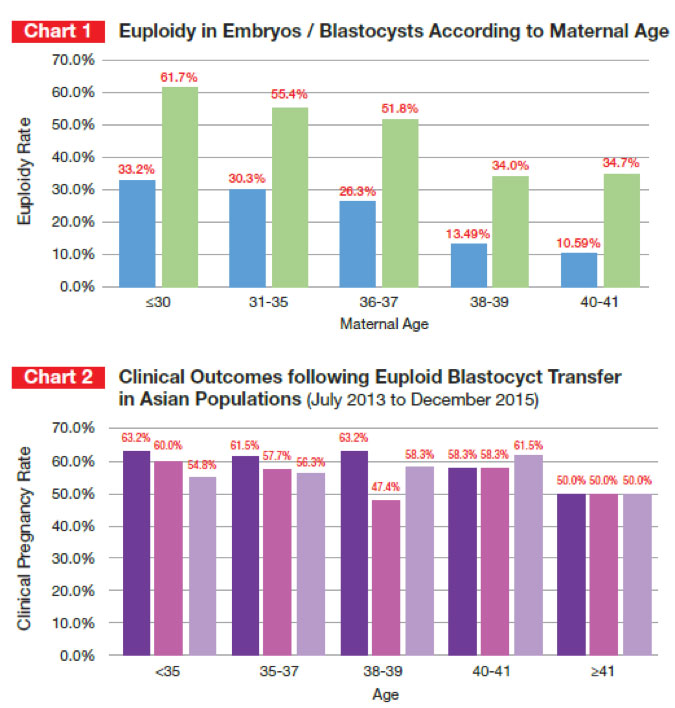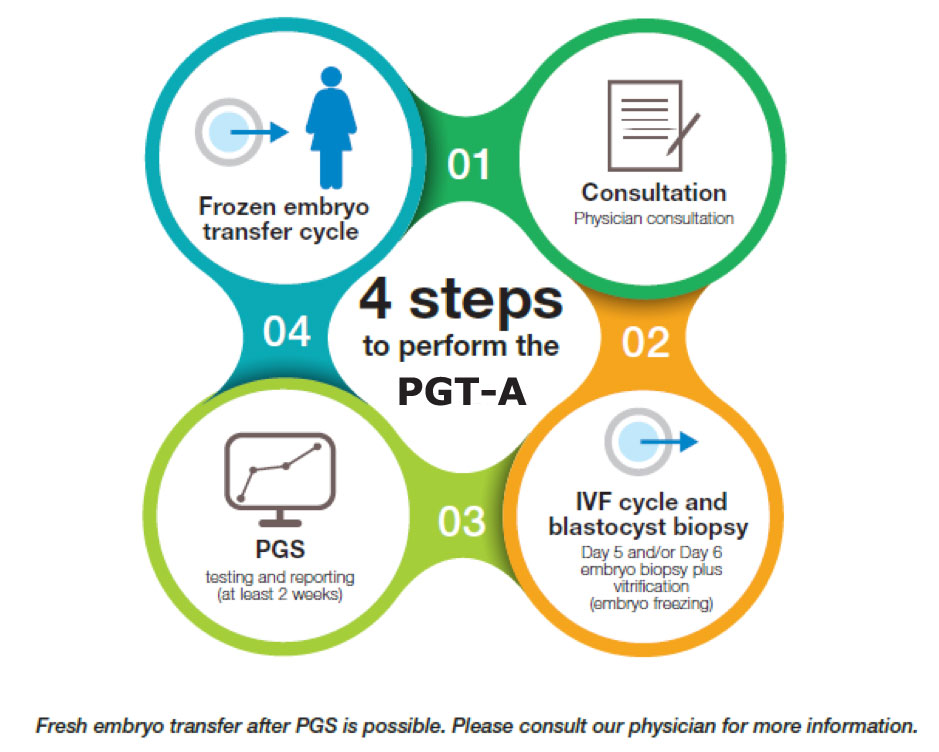What is PGT-A?
PGT-A, or preimplantation genetic testing for aneuploidies was formerly known as PGS, preimplantation genetic screening.
PGT-A is a reproductive technology used with an in vitro fertilisation (IVF) cycle. It is used to analyse the chromosomes of the embryos before their transfer into the womb. The purpose of PGT-A is to increase the chance of becoming pregnant and to lower the risk of miscarriage or risk of having a chromosomally abnormal child. The test is performed by extracting a single or few cells from the embryo produced through IVF. A PGT-A test reveals the number of chromosomes from each embryo. The correct number of chromosomes (46) is necessary for the embryo to become a normal child.
PGT-A enables the checking of all 23 sets of chromosomes including X and Y in each embryo so that only normal embryos are selected for transfer into the womb.
Example A : a pair of chromosome 21 is normal ; three chromosomes of 21 is Down’s Syndrome
Example B : abnormalities of chromosome 23 such as :-
- XO (abnormal girl – Turner’s Syndrome),
- XXY (abnormal boy – Klinefelter’s) compared to
- XX (normal girl) or
- XY (normal boy)
INDICATIONS FOR PGT-A
You may with to consider PGT-A if :
- You want to improve your IVF pregnancy rate – even women as young as 30 years old have a 70% chance of chromosome abnormalities in their embryos (refer Chart 1 below).
- Especially if you are a women over 35 as the incidence of aneuploidy (abnormal number of chromosomes) increases significantly with advancing maternal age. Transferring euploid embryos in older women achieves the same implantation rates as those in younger women (refer Chart 2 below).
- You have experienced several spontaneous miscarriages.
- You have experienced several failed IVF cycles.
- Your partner has severe male factor infertility.
- You have had a prior pregnancy with a chromosomal abnormality.
- You and/or your partner carry a balanced structural chromosome rearrangement eg. Translocations or inversions.
- You and/or your partner carry an X-linked disease.
The selection of chromosomally normal embryos in these couples greatly reduces the risk of miscarriage and increases reproductive success.

Chart 1 ref :
Yap WY; Lim YX; Lee CSS (Alpha Fertility Centre).
Euploidy rates of Cleavage Stage Embryos vs Blastocysts following PGS in an Asian Population.
15th International Conference on Preimplantation Genetic Diagnosis (PGDIS), 8-11th May 2016, Bologna, Italy.
Chart 2 ref :
Lee CSS; Low SY; Lim YX; Keith J (Alpha Fertility Centre).
Maternal age does not affect clinical outcomes of vitrified-warmed euploid blastocysts: an Asian Study.
15th International Conference on Preimplantation Genetic Diagnosis (PGDIS), 8-11th May 2016, Bologna, Italy.
Benefits of PGT – A
The majority of abnormal embryos are indistinguishable from normal embryos when studied under a microscope. The appearance of an embryo cannot be used to evaluate chromosomal abnormalities.
The main benefits of PGT – A for chromosomal abnormalities include :
- The selection of normal embryos for transfer
- Increase in implantation rate
- Reduction in miscarriage rate
- Avoids amniocentesis and its associated risks
- Increase the change of having a healthy baby
- Decrease the time to achieve a pregnancy



